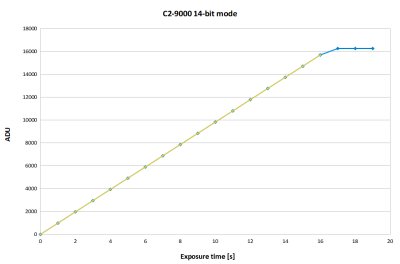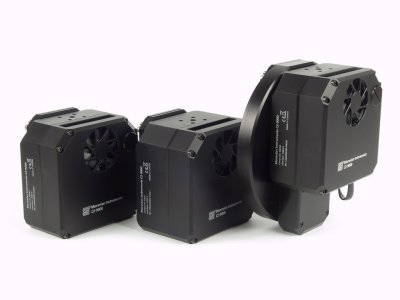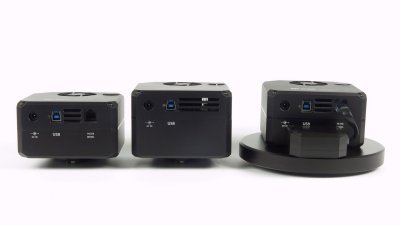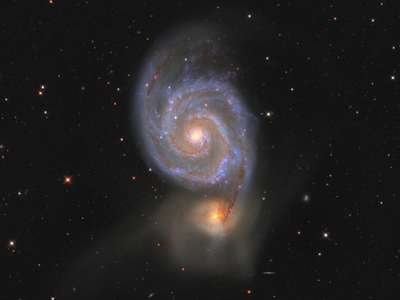C2 camera with rolling shutter sensor
All current C2 cameras employ Sony IMX sensor with global
shutter. The C2-9000 is the first C2 camera with back
illuminated Sony IMX533 CMOS sensor with rolling
shutter and 3.76 × 3.76 μm pixels.
| Model |
CMOS sensor |
Resolution |
Pixel size |
Image area |
| C2-9000 |
IMX533 |
3008 × 3008 pixels |
3.76 × 3.76 μm |
11.31 × 11.31 mm |
C2-9000 camera head with internal filter
wheel The IMX533 sensor used in C2-9000 camera shows very good
linearity in response to light. This means the camera can be used
for advanced research projects, like the photometry of variable
stars and transiting exoplanets etc.

Response of the Sony IMX rolling-shutter sensor
(IMX533) Controlling of the rolling shutter sensors differs
significantly from controlling of the global shutter sensors and
thus the camera C2-9000 internals are quite different from other
C2 models.
The C2-9000 contains 256 MB of
onboard memory, capable to store up to 14 full-resolution frames.
Camera API allows for sequential exposures, during which
short-exposure images are stored into memory possibly faster than
the host computer is able to read them. Sequential exposures are
paused when the internal memory is filled with images, not yet
read by the host PC. As explained earlier, rolling shutter sensors
are capable to perform image exposure while digitizing the
previous image.

C2-9000 camera without filter wheel (left), with
internal filter wheel (center) and with external filter wheel
(right) Thanks to C2-9000 onboard RAM, downloading of the image to the
host computer does not influence image digitization process, as
the download only transfers already digitized images from camera
memory.
Time needed to digitize and download single full frame
depends on USB connection type.
Full-frame, USB 3.0
(5 Gbps):
0.06 s Full-frame, USB 2.0
(480 Mbps):
0.40 s
Generally, many sensor characteristics depend on the used
gain.
| Gain number |
Gain in dB |
Gain multiply |
Conversion factor |
Read noise RMS |
Full well capacity |
| 0 |
0.0 dB |
1× |
3.05 e-/ADU |
3.90 e- |
50,000 e- |
| 4030 |
36.0 dB |
63× |
0.06 e-/ADU |
2.76 e- |
950 e- |
The camera driver and user’s applications offer wide
variety of binning modes up to 4 × 4 pixels as well as all combinations of
asymmetrical binning modes 1 × 2,
1 × 3, 1 × 4, 2 × 4 etc. To
allow such flexibility, binning is performed only in the camera
driver (software binning) and does not rely on the limited
capabilities of the hardware binning.
The negative side of software binning is the same download time
like in the case of full-resolution 1 × 1 mode. This is why the C2-9000 camera also
implements 2 × 2 binning mode in
camera hardware.
The shortest theoretical exposure time of the C2-9000
camera is 49 μs. However, such short exposures have no practical
application, especially in astronomy. The camera firmware rounds
exposure time to a multiply of 100 μs intervals, so in
reality the shortest exposure time is also 100 μs.
There is no theoretical limit on maximal exposure length, but
in reality, the longest exposures are limited by saturation of the
sensor either by incoming light or by dark current.

C2-9000 camera variant interfaces Other C2-9000 camera features like cooling efficiency,
12 V DC
power and USB3 connection, telescope interfaces etc. are the same
like the other C2 camera lines. Refer to the C2
camera product page for more details.
C2-9000 first light
 |
| Object |
M51 “Whirlpool Galaxy” |
| Author |
Martin Myslivec |
| Camera |
C2-9000 |
| Filters |
LRGB |
| Exposure |
10 hours (2.5
hour per LRGB channel) |
| Telescope |
400 mm
f/2.9 astrograph |
|
| 